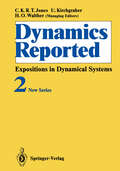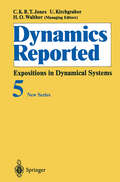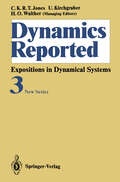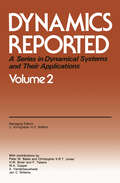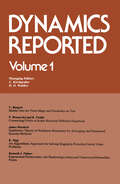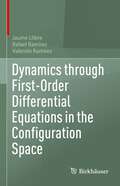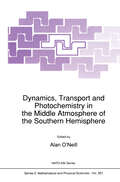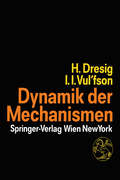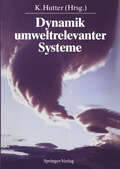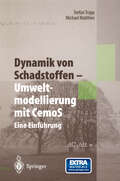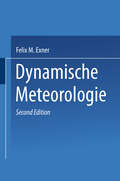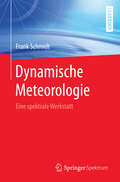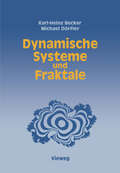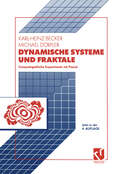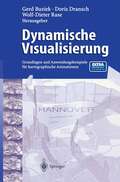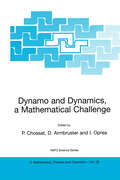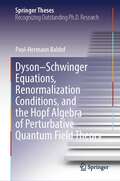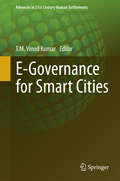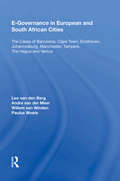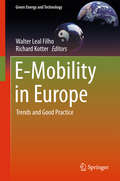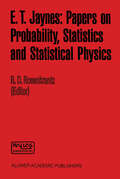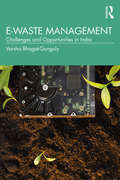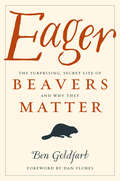- Table View
- List View
Dynamics Reported: Expositions in Dynamical Systems (Dynamics Reported. New Series #2)
by H. S. Dumas C. Genecand J. Henrard J. KomornikDYNAMICS REPORTED reports on recent developments in dynamical systems. Dynamical systems of course originated from ordinary differential equations. Today, dynamical systems cover a much larger area, including dynamical pro cesses described by functional and integral equations, by partial and stochastic differential equations, etc. Dynamical systems have involved remarkably in recent years. A wealth of new phenomena, new ideas and new techniques are proving to be of considerable interest to scientists in rather different fields. It is not surprising that thousands of publications on the theory itself and on its various applications are appearing. DYNAMICS REPORTED presents carefully written articles on major sub jects in dynamical systems and their applications, addressed not only to special ists but also to a broader range of readers including graduate students. Topics are advanced, while detailed exposition of ideas, restriction to typical result- rather than the most general ones - and, last but not least, lucid proofs help to gain the utmost degree of clarity. It is hoped, that DYNAMICS REPORTED will be useful for those enter ing the field and will stimulate an exchange of ideas among those working in dynamical systems.
Dynamics Reported: Expositions in Dynamical Systems (Dynamics Reported. New Series #5)
by N. Fenichel P. Koch Medina D. W. McLaughlin X. Lin E.A.II Overman S. Wiggins C. XiongDYNAMICS REPORTED reports on recent developments in dynamical systems. Dynamical systems of course originated from ordinary differential equations. Today, dynamical systems cover a much larger area, including dynamical processes described by functional and integral equations, by partial and stochastic differential equations, etc. Dynamical systems have involved remarkably in recent years. A wealth of new phenomena, new ideas and new techniques are proving to be of considerable interest to scientists in rather different fields. It is not surprising that thousands of publications on the theory itself and on its various applications are appearing DYNAMICS REPORTED presents carefully written articles on major subjects in dynam ical systems and their applications, addressed not only to specialists but also to a broader range of readers including graduate students. Topics are advanced, while detailed expo sition of ideas, restriction to typical results - rather than the most general ones - and, last but not least, lucid proofs help to gain the utmost degree of clarity. It is hoped, that DYNAMICS REPORTED will be useful for those entering the field and will stimulate an exchange of ideas among those working in dynamical systems Summer 1991 Christopher K. R. T Jones Drs Kirchgraber Hans-Otto Walther Managing Editors Table of Contents Hyperbolicity and Exponential Dichotomy for Dynamical Systems Neil Fenichel 1. Introduction . . . . . . . . . . . . . . . . . . I 2. The Main Lemma . . . . . . . . . . . . . . . . 2 3. The Linearization Theorem of Hartman and Grobman 5 4. Hyperbolic Invariant Sets: €-orbits and Stable Manifolds 6 5.
Dynamics Reported: Expositions in Dynamical Systems New Series: Volume 3 (Dynamics Reported. New Series #3)
by G. Fournier I. Lasiecka D. Lupo Y. Nishiura M. Ramos R. Triggiani M. WillemDYNAMICS REPORTED reports on recent developments in dynamical systems. Dynamical systems of course originated from ordinary differential equations. Today, dynamical systems cover a much larger area, including dynamical processes described by functional and integral equations, by partial and stochastic differential equations, etc. Dynamical systems have involved remarkably in recent years. A wealth of new phenomena, new ideas and new techniques are proving to be of considerable interest to scientists in rather different fields. It is not surprising that thousands of publications on the theory itself and on its various applications are appearing DYNAMICS REPORTED presents carefully written articles on major subjects in dynamical systems and their applications, addressed not only to specialists but also to a broader range of readers including graduate students. Topics are advanced, while detailed exposition of ideas, restriction to typical results - rather than the most general one- and, last but not least, lucid proofs help to gain the utmost degree of clarity. It is hoped, that DYNAMICS REPORTED will be useful for those entering the field and will stimulate an exchange of ideas among those working in dynamical systems Summer 1991 Christopher K. R. T Jones Drs Kirchgraber Hans-Otto Walther Managing Editors Table of Contents Limit Relative Category and Critical Point Theory G. Fournier, D. Lupo, M. Ramos, M. Willem 1. Introduction. . . . . . . . . . . . . . . . . . . . . . . . . . . . . . . . . . . . . . . . . . . . . . . . . . . . . . . . . . . 1 2. Relative Category . . . . . . . . . . . . . . . . . . . . . . . . . . . . . . . . . . . . . . . . . . . . . . . . . . . . . . 2 3. Relative Cupiength . . . . . . . . . . . . . . . . . . . . . . . . . . . . . . . . . . . . . . . . . . . . . . . . . . . . . 6 4. Limit Relative Category . . . . . . . . . . . . . . . . . . . . . . . '" . . . . " . . . . . . . . . . . . . . . . 10 5. The Deformation Lemma . . . . . . . . . . . . . . . . . . . . . . . . . . . . . . . . . . . . . . . . . . . . . . . 11 6. Critical Point Theorems . . . . . . . . . . . . . . . . . . . . . . . . . . . . . . . . . . . . . . . . . . . . . . . . 13 7. Some Applications . . . . . . . . . . . . . . . . . . . . . . . . . . . . . . . . . . . . . . . . . . . . . . . . . . . . . .
Dynamics Reported: A Series in Dynamical Systems and Their Applications (Dynamics Reported. New Series #2)
by Urs Kirchgraber Hans Otto WaltherDynamics through First-Order Differential Equations in the Configuration Space
by Jaume Llibre Rafael Ramírez Valentín RamírezThe goal of this monograph is to answer the question, is it possible to solve the dynamics problem inside the configuration space instead of the phase space? By introducing a proper class of vector field – the Cartesian vector field – given in a Riemann space, the authors explore the connections between the first order ordinary differential equations (ODEs) associated to the Cartesian vector field in the configuration space of a given mechanical system and its dynamics. The result is a new perspective for studying the dynamics of mechanical systems, which allows the authors to present new cases of integrability for the Suslov and Veselova problem; establish the relation between the Cartesian vector field and the integrability of the geodesic flow in a special class of homogeneous surfaces; discuss the importance of the Nambu bracket in the study of first order ODEs; and offer a solution of the inverse problem in celestial mechanics.
Dynamics, Transport and Photochemistry in the Middle Atmosphere of the Southern Hemisphere (Nato Science Series C: #321)
by A. O'NeillThe NATO Advanced Research Workshop on "Dynamics, Transport am. Photochemistry in the Middle Atmosphere of the Southern Hemisphere" was held in San Francisco, California, U.S.A., 15-17 April 1989. In addition to NATO, the workshop was supported by the University of California, Los Angeles, and by the National Aeronautics and Space Administration, U.S.A. (NASA). The American Meteorological Society was a co-operating organization. The venue for the workshop was the Lone Mountain Conference Center of the University of San Francisco. The workshop was organized and directed by Dr A.O'Neill (Hadley Centre for Climate Prediction and Research, Meteorological Office, Bracknell, U.K.) and Prof C.R. Mechoso (Dept of Atmospheric Sciences, University of California, Los Angeles, U.S.A.). The workshop was the third one held as part of the Middle Atmosphere in the Southern Hemisphere (MASH) project, an international effort (under the auspices of the Middle Atmosphere Program) to learn more about dynamics, transport and photochemistry in the middle atmosphere of the southern hemisphere. Before the discovery that, during recent years, a dramatic thinning of the ozone layer takes place over Antarctica in spring - the "ozone hole" - the middle atmosphere of the southern hemisphere had received much less attention than that of the northern hemisphere from meteorologists and atmospheric chemists. The MASH project was instituted to remedy this comparative lack of interest.
Dynamik umweltrelevanter Systeme
by E. Augstein H. Blatter B. Diekmann H. Fleer F. Gassmann H. Grassl G. Gross K. Herterich K. Hutter W. Klug G. Manier A. Neftel A. Ohmura C. D. Schönwiese F. H. Schwarzenbach M. M. TilzerDynamik von Schadstoffen — Umweltmodellierung mit CemoS: Eine Einführung
by Stefan Trapp Michael MatthiesDas Buch wendet sich an alle, die Interesse an dem immer wichtiger werdenden Gebiet der Schadstoffausbreitung in der Umwelt haben. Der didaktisch gut aufbereitete Text erleichtert den schnellen Einstieg ohne überflüssigen mathematischen Ballast und ermuntert zum Selbststudium. Die Modelle werden Schritt für Schritt und nach einem einheitlichen Konzept erläutert. Übungsaufgaben im Buch und die Diskette mit Modelling-Software (CemoS), Übungsdatensätzen sowie eine Substanz- und Umweltdatenbank für IBM-PC und Kompatible sichern und festigen das erworbene Wissen und erlauben eigene Berechnungen.
Dynamische Meteorologie
by Felix M. ExnerDieser Buchtitel ist Teil des Digitalisierungsprojekts Springer Book Archives mit Publikationen, die seit den Anfängen des Verlags von 1842 erschienen sind. Der Verlag stellt mit diesem Archiv Quellen für die historische wie auch die disziplingeschichtliche Forschung zur Verfügung, die jeweils im historischen Kontext betrachtet werden müssen. Dieser Titel erschien in der Zeit vor 1945 und wird daher in seiner zeittypischen politisch-ideologischen Ausrichtung vom Verlag nicht beworben.
Dynamische Meteorologie: Eine spektrale Werkstatt
by Frank SchmidtWie Frank Schmidt in diesem Lehrbuch zeigt, ist Meteorologie noch mehr als ein Handwerk! Angesichts der großen Familie nationaler und größerräumiger Vorhersagemodelle mit Modulen und Parametern, offen für aktuelle Messungen, und angesichts des technologischen Fortschritts mit Radar- und Satellitenbeobachtung könnte man das fast vergessen haben.Tatsächlich zeigt die Dynamik, das Herz der Modelle, bei sensiblen Abschätzungen und Feinabstimmungen solcher Modelle erstaunlich variierende Ergebnisse. Es existiert eine Vielfalt zu überdenkender Zusammenhänge und auszulotender Grenzen, und das selbst schon im Grundlegenden und Linearen. Das wird durch nichts so anschaulich dargestellt wie durch spektrale Methoden.Zunächst werden grundlegende dynamische Gleichungen quasi axiomatisch gegeben und dann für verschiedene Größenordnungen der Bewegung dynamische Äquivalenzklassen definiert, die meteorologischen Modelle.Kugelflächenfunktionen werden elementar als Polynome der sphärischen Polarkoordinaten eingeführt und die globalen dynamischen Operationen als Rekursionen dieser Polynome identifiziert. Damit wird die sphärische Symmetrie per definitionem respektiert, insbesondere auch eingebettet in den Torus oder mit regional erhöhter Auflösung. Angefangen bei diesen globalen Symmetrien gilt es auch zu arbeiten mit der vertikalen Struktur, mit Eigenschwingungen bei variierenden Modellen, Schichtungen, Randstrukturen und Anregungen. Bei Überlappung von Rossby- und Schwerewellen treten Instabilitäten auf. Adaptationen von Frequenzen ergeben sich auflösungsabhängig. Barokline Instabilität erscheint von der synoptischen Skala bis in kleinste Skalen fortgesetzt, soweit das Modell trägt.Kaum bewusst gewordene Instabilitäten und unerwünschte Dämpfungen finden sich bei etablierten Zeititerationen, Defizite für Lorenz'sche "Klimaprognosen". Bekannte statistische Verfahren der Analyse entpuppen sich als Strukturen von aufregend vielfach überlagerten Mannigfaltigkeiten. Höchste Effizienz der Prognose wird elementar realisiert.
Dynamische Systeme und Fraktale: Computergrafische Experimente mit Pascal
by Karl-Heinz Becker Michael DörflerOft wird heute im Zusammenhang mit der "Theorie komplexer dynamischer Systeme" von einer wissenschaftlichen Revolution gesprochen, die in alle Wis senschaften ausstrahlt. Computergrafische Methoden und Experimente bestim men heute die Arbeitsweise eines neuen Teilgebietes der Mathematik: der "experimentellen Mathematik". Ihr Inhalt ist neben anderem die Theorie kom plexer, dynamischer Systeme. Erstmalig wird hier experimentell mit Computer systemen und Computergrafik gearbeitet. Gegenstand der Experimente sind "mathematische Rückkopplungen", die mit Hilfe von Computern berechnet und deren Ergebnisse durch computergrafische Methoden dargestellt werden. Die rätselhaften Strukturen dieser Computergrafiken bergen Geheimnisse, die heute noch weitgehend unbekannt sind und eine Umkehrung des Denkens in vielen Bereichen der Wissenschaft bewirken werden. Handelt es sich hierbei tatsächlich um eine Revolution, dann muß dasselbe wie für andere Revolutionen gelten: • die äußere Sitution muß dementsprechend vorbereitet sein und • es muß jemand da sein, der neue Erkenntnisse auch umsetzt. Wir denken, daß die äußere günstige Forschungssituation durch die massenhafte und preisgünstige Verbreitung von Computern geschaffen wurde. Mehr und mehr haben sie sich als unverzichtbare Arbeitswerkzeuge durchgesetzt. Es ist aber immer die wissenschaftliche Leistung einzelner gewesen, das was möglich ist, auch zu tun. Hier sei zunächst der Name Benoit B. Mandelbrots erwähnt. Diesem wissenschaftlichen Aussenseiter ist es in langjähriger Arbeit gelungen, den grundlegenden mathematischen Begriff des "Fraktals" zu entwickeln und mit Leben zu füllen. Andere Arbeitgruppen waren es, die die speziellen grafischen Möglichkeiten weiterentwickelten.
Dynamische Systeme und Fraktale: Computergrafische Experimente mit Pascal
by Michael DörflerOft wird heute im Zusammenhang mit der "Theorie komplexer dynamischer Systeme" von einer wissenschaftlichen Revolution gesprochen, die in alle Wis senschaften ausstrahlt. Computergrafische Methoden und Experimente bestim men heute die Arbeitsweise eines neuen Teilgebietes der Mathematik: der "experimentellen Mathematik". Ihr Inhalt ist neben anderem die Theorie kom plexer, dynamischer Systeme. Erstmalig wird hier experimentell mit Computer systemen und Computergrafik gearbeitet. Gegenstand der Experimente sind "mathematische Rückkopplungen", die mit Hilfe von Computern berechnet und deren Ergebnisse durch computergrafische Methoden dargestellt werden. Die rätselhaften Strukturen dieser Computergrafiken bergen Geheimnisse, die heute noch weitgehend unbekannt sind und eine Umkehrung des Denkens in vielen Bereichen der Wissenschaft bewirken werden. Handelt es sich hierbei tatsächlich um eine Revolution, dann muß dasselbe wie für andere Revolutionen gelten: • die äußere Sitution muß dementsprechend vorbereitet sein und • es muß jemand da sein, der neue Erkenntnisse auch umsetzt. Wir denken, daß die äußere günstige Forschungssituation durch die massenhafte und preisgünstige Verbreitung von Computern geschaffen wurde. Mehr und mehr haben sie sich als unverzichtbare Arbeitswerkzeuge durchgesetzt. Es ist aber immer die wissenschaftliche Leistung einzelner gewesen, das was möglich ist, auch zu tun. Hier sei zunächst der Name Benoit B. Mandelbrots erwähnt. Diesem wissenschaftlichen Aussenseiter ist es in langjähriger Arbeit gelungen, den grundlegenden mathematischen Begriff des "Fraktals" zu entwickeln und mit Leben zu füllen. Andere Arbeitgruppen waren es, die die speziellen grafischen Möglichkeiten weiterentwickelten.
Dynamische Visualisierung: Grundlagen und Anwendungsbeispiele für kartographische Animationen
by Gerd Buziek Doris Dransch Wolf-Dieter RaseDynamische Visualisierung: Grundlagen mit Anwendungsbeispielen aus der Kartographie richtet sich in erster Linie an Praktiker, die kartographische Animationen erstellen wollen. Das Buch bietet einen leichten Einstieg in die Thematik sowie konkrete Hilfestellung für die Praxis. Es werden technische und methodische Grundlagen vermittelt und Erfahrungen von Fachleuten anhand von Beispielen aus unterschiedlichen Anwendungsbereichen beschrieben. Darüber hinaus werden Gestaltungsprinzipien kartographischer Animation aus konzeptioneller und anwendungsbezogener Sicht vorgestellt. Aus technischer Sicht wird auf Herstellungsverfahren, Hard- und Software sowie auf Internetanwendungen eingegangen. Die Beispiele der Animationssequenzen sind auf der beiliegenden CD-ROM gespeichert.
Dynamo and Dynamics, a Mathematical Challenge (NATO Science Series II: Mathematics, Physics and Chemistry #26)
by Pascal Chossat Dieter Armbruster Iuliana OpreaThis book contains the lectures given at the workshop "Dynamo and dynamics, a mathematical challenge" held in Cargese from August 21 to 26, 2000. The workshop differed from most previous conferences on the dynamo effect in two important respects. First, it was at this international conference that the experimental observation of homogeneous fluid dynamos was first reported. Second, the conference gathered scientists from very different fields, thus showing that thepynamo problem has become an interdisciplinary subject involving not only astrophysicists and geophysicists, but also scientists working in dynamical systems theory, hydrodynamics, and numerical simulation, as well as several groups in experimental physics. This book thus reports important results on various dynamo studies in these different contexts: - Decades after the discovery of the first analytic examples of laminar fluid dynamos, the self-generation of a magnetic field by a flow ofliquid sodium has been reported by the Karlsruhe and Riga groups. Although there were no doubts concerning the self generation by the laminar Roberts-type or Ponomarenko-type flows that were used, these experiments have raised interesting questions about the influence of the turbulent fluctuations on the dynamo threshold and on the saturation level of the magnetic field.
Dyson–Schwinger Equations, Renormalization Conditions, and the Hopf Algebra of Perturbative Quantum Field Theory (Springer Theses)
by Paul-Hermann BaldufThis book offers a systematic introduction to the Hopf algebra of renormalization in quantum field theory, with a special focus on physical motivation, the role of Dyson–Schwinger equations, and the renormalization group. All necessary physical and mathematical constructions are reviewed and motivated in a self-contained introduction. The main part of the book concerns the interplay between Dyson–Schwinger equations (DSEs) and renormalization conditions. The book is explicit and consistent about whether a statement is true in general or only in particular renormalization schemes or approximations and about the dependence of quantities on regularization parameters or coupling constants. With over 600 references, the original literature is cited whenever possible and the book contains numerous references to other works discussing further details, generalizations, or alternative approaches. There are explicit examples and remarks to make the connection from the scalar fields at hand toQED and QCD. The book is primarily targeted at the mathematically oriented physicist who seeks a systematic conceptual overview of renormalization, Hopf algebra, and DSEs. These may be graduate students entering the field as well as practitioners seeking a self-contained account of the Hopf algebra construction. Conversely, the book also benefits the mathematician who is interested in the physical background of the exciting interplay between Hopf algebra, combinatorics and physics that is renormalization theory today.
E-Governance for Smart Cities (Advances in 21st Century Human Settlements)
by T. M. Vinod KumarThis book highlights the electronic governance in a smart city through case studies of cities located in many countries. “E-Government” refers to the use by government agencies of information technologies (such as Wide Area Networks, the Internet, and mobile computing) that have the ability to transform relations with citizens, businesses, and other arms of government. These technologies can serve a variety of different ends: better delivery of government services to citizens, improved interactions with business and industry, citizen empowerment through access to information, or more efficient government management. The resulting benefits are less corruption, increased transparency, greater convenience, revenue growth, and/or cost reductions. The book is divided into three parts.• E-Governance State of the Art Studies of many cities• E-Governance Domains Studies• E-Governance Tools and Issues
E-Governance in European and South African Cities: The Cases of Barcelona, Cape Town, Eindhoven, Johannesburg, Manchester, Tampere, The Hague and Venice
by Leo van den Berg Andre van der Meer Willem van Winden Paulus WoetsSince the late 1990s, city councils have become increasingly aware of the potential for information technologies (ICTs) to improve the management of cities and as an instrument for economic and social policy. This has resulted in a wave of urban ICT strategies and policies, such as the adoption of ICTs within the city administration itself, projects that facilitate access to ICTs by weaker social groups and policies to improve the urban electronic infrastructure. By comparing eight cities - Barcelona, Cape Town, Eindhoven, Johnnesburg, Manchester, Tampere, the Hague and Venice - this book examines a range of innovative urban e-governance strategies and develops a framework of analysis that permits a common approach. Throughout the book, a distinction is made between access policies (aimed at improving access to ICTs for all citizens), content policies (directed to improve the use of ICTs in the city administration and semi-public domains) and infrastructure policies (to improve the provision of broadband infrastructure). For each of the cities, e-strategies and policies are critically reviewed and compared. The book reveals that urban e-strategies have evolved from an internal and technology-centred orientation to a more outward-looking approach.
E-Governance in European and South African Cities: The Cases of Barcelona, Cape Town, Eindhoven, Johannesburg, Manchester, Tampere, The Hague and Venice
by Leo van den Berg Andre van der Meer Willem van Winden Paulus WoetsSince the late 1990s, city councils have become increasingly aware of the potential for information technologies (ICTs) to improve the management of cities and as an instrument for economic and social policy. This has resulted in a wave of urban ICT strategies and policies, such as the adoption of ICTs within the city administration itself, projects that facilitate access to ICTs by weaker social groups and policies to improve the urban electronic infrastructure. By comparing eight cities - Barcelona, Cape Town, Eindhoven, Johnnesburg, Manchester, Tampere, the Hague and Venice - this book examines a range of innovative urban e-governance strategies and develops a framework of analysis that permits a common approach. Throughout the book, a distinction is made between access policies (aimed at improving access to ICTs for all citizens), content policies (directed to improve the use of ICTs in the city administration and semi-public domains) and infrastructure policies (to improve the provision of broadband infrastructure). For each of the cities, e-strategies and policies are critically reviewed and compared. The book reveals that urban e-strategies have evolved from an internal and technology-centred orientation to a more outward-looking approach.
E-Mobility in Europe: Trends and Good Practice (Green Energy and Technology)
by Walter Leal Filho Richard KotterFocusing on technical, policy and social/societal practices and innovations for electrified transport for personal, public and freight purposes, this book provides a state-of-the-art overview of developments in e-mobility in Europe and the West Coast of the USA. It serves as a learning base for further implementing and commercially developing this field for the benefit of society, the environment and public health, as well as for economic development and private industry. A fast-growing, interdisciplinary sector, electric mobility links engineering, infrastructure, environment, transport and sustainable development. But despite the relevance of the topic, few publications have ever attempted to document or promote the wide range of electric mobility initiatives and projects taking place today. Addressing this need, this publication consists of case studies, reports on technological developments and examples of successful infrastructure installation in cities, which document current initiatives and serve as an inspiration for others.
E. T. Jaynes: Papers on Probability, Statistics and Statistical Physics (Synthese Library #158)
by R. D. RosenkrantzThe first six chapters of this volume present the author's 'predictive' or information theoretic' approach to statistical mechanics, in which the basic probability distributions over microstates are obtained as distributions of maximum entropy (Le. , as distributions that are most non-committal with regard to missing information among all those satisfying the macroscopically given constraints). There is then no need to make additional assumptions of ergodicity or metric transitivity; the theory proceeds entirely by inference from macroscopic measurements and the underlying dynamical assumptions. Moreover, the method of maximizing the entropy is completely general and applies, in particular, to irreversible processes as well as to reversible ones. The next three chapters provide a broader framework - at once Bayesian and objective - for maximum entropy inference. The basic principles of inference, including the usual axioms of probability, are seen to rest on nothing more than requirements of consistency, above all, the requirement that in two problems where we have the same information we must assign the same probabilities. Thus, statistical mechanics is viewed as a branch of a general theory of inference, and the latter as an extension of the ordinary logic of consistency. Those who are familiar with the literature of statistics and statistical mechanics will recognize in both of these steps a genuine 'scientific revolution' - a complete reversal of earlier conceptions - and one of no small significance.
E-Waste Management: Challenges and Opportunities in India
by Varsha Bhagat-GangulyThis book offers an extensive review of e-waste management in India, the world’s third‑largest producer of waste from electrical and electronic equipment. With a focus on the evolution of legalframeworks in India and the world, it presents impacts and outcomes; challenges and opportunities; and management strategies and practices to deal with e-waste. First of its kind, the book examines relevant concepts and issues from across 15 disciplines and six areas of policy making and will serve as a comprehensive knowledge base on electronic waste in India. It links key themes to the global context of Sustainable Development Goals and explores the convergence with technological, infrastructural, and social initiatives in e-waste management. A range of topics are discussed, such as resource efficiency policies; circular economy; toxicity; technicalities and complexities of e-waste management including role of the informal sector and need for recognising social and human costs in policy making. The book deals with the role of statistics; legal trends and reforms; linkages with green Agenda 2030 and UN initiatives; implementation of Extended Producer Responsibility (EPR); environmental factors; business prospects; consequences on human health; Life Cycle Impact Assessment; the ‘six Rs’ (Responsible use, Repair, Refurbish, Recycle, Recover and Reuse); recycling practices and problems, material flow and informal sector in trade value chain; fostering partnership between formal-informal sectors; safe disposal; alternatives to landfilling; role of jurisprudence and regulatory bodies; and education and awareness. It also includes a survey of pan-India initiatives and trajectories of law-driven initiatives for effective e-waste management along with responses from industries and producers. Timely and essential, this volume will be useful to scholars and researchers of environment studies, digital waste management, waste management, development studies, public policy, political ecology, sustainable development, technology and manufacturing, design and instrumentation, environmental and international law, taxation, commerce, electronic industry, economics, business management, metallurgy, and engineering, labour studies, as well as to policymakers, nongovernmental organisations, and interested general readers.
E-Waste Management: Challenges and Opportunities in India
by Varsha Bhagat-GangulyThis book offers an extensive review of e-waste management in India, the world’s third‑largest producer of waste from electrical and electronic equipment. With a focus on the evolution of legalframeworks in India and the world, it presents impacts and outcomes; challenges and opportunities; and management strategies and practices to deal with e-waste. First of its kind, the book examines relevant concepts and issues from across 15 disciplines and six areas of policy making and will serve as a comprehensive knowledge base on electronic waste in India. It links key themes to the global context of Sustainable Development Goals and explores the convergence with technological, infrastructural, and social initiatives in e-waste management. A range of topics are discussed, such as resource efficiency policies; circular economy; toxicity; technicalities and complexities of e-waste management including role of the informal sector and need for recognising social and human costs in policy making. The book deals with the role of statistics; legal trends and reforms; linkages with green Agenda 2030 and UN initiatives; implementation of Extended Producer Responsibility (EPR); environmental factors; business prospects; consequences on human health; Life Cycle Impact Assessment; the ‘six Rs’ (Responsible use, Repair, Refurbish, Recycle, Recover and Reuse); recycling practices and problems, material flow and informal sector in trade value chain; fostering partnership between formal-informal sectors; safe disposal; alternatives to landfilling; role of jurisprudence and regulatory bodies; and education and awareness. It also includes a survey of pan-India initiatives and trajectories of law-driven initiatives for effective e-waste management along with responses from industries and producers. Timely and essential, this volume will be useful to scholars and researchers of environment studies, digital waste management, waste management, development studies, public policy, political ecology, sustainable development, technology and manufacturing, design and instrumentation, environmental and international law, taxation, commerce, electronic industry, economics, business management, metallurgy, and engineering, labour studies, as well as to policymakers, nongovernmental organisations, and interested general readers.
Eager: The Surprising, Secret Life of Beavers and Why They Matter
by Ben GoldfarbIn Eager, environmental journalist Ben Goldfarb reveals that our modern idea of what a healthy landscape looks like and how it functions is wrong, distorted by the fur trade that once trapped out millions of beavers from North America’s lakes and rivers. The consequences of losing beavers were profound: streams eroded, wetlands dried up, and species from salmon to swans lost vital habitat. Today, a growing coalition of “Beaver Believers”—including scientists, ranchers, and passionate citizens—recognizes that ecosystems with beavers are far healthier, for humans and non-humans alike, than those without them. From the Nevada deserts to the Scottish highlands, Believers are now hard at work restoring these industrious rodents to their former haunts. Eager is a powerful story about one of the world’s most influential species, how North America was colonized, how our landscapes have changed over the centuries, and how beavers can help us fight drought, flooding, wildfire, extinction, and the ravages of climate change. Ultimately, it’s about how we can learn to coexist, harmoniously and even beneficially, with our fellow travelers on this planet.
